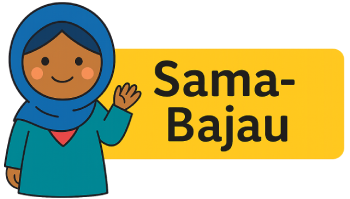The Sama-Bajau languages represent a fascinating group of closely related language varieties spoken by maritime communities across Southeast Asia. Primarily used in the Philippines, Malaysia, and Indonesia, these languages are closely associated with the seafaring lifestyles of their speakers, who are often called "sea nomads." Many of the current speakers are descendants of these maritime nomads, though some communities have transitioned to a more sedentary way of life.

The term Sama is widely believed to originate from the Malay and Tagalog word sama-sama, meaning “together.” In related languages, such as Malay (sama) and Cebuano (sama), the word can mean “same,” “matching,” or “including.” In Tagalog, -sama is a verb root meaning “to take along.” However, this interpretation may represent folk etymology, as alternative names like Samal, Siyama, and Sinama suggest a more complex linguistic history.
Sama-Bajau languages are spoken in the southwestern Philippines, particularly in the Sulu Archipelago, as well as in Sabah on the island of Borneo in Malaysia, and across coastal areas of Sulawesi (Celebes) in Indonesia. Over time, migration, trade, and historical maritime activities have spread these languages to other regions of the Philippines, including coastal Mindanao, Cebu Island, and parts of Luzon south of Manila.
The Sama-Bajau languages can be classified into three primary groups with multiple dialects:
The Sama-Bajau varieties are mutually intelligible to varying degrees, not only among themselves but also with other closely related languages in the region such as Tausug. In addition to their native linguistic skills, many Sama-Bajau speakers are multilingual, often proficient in Tausug, Cebuano, Chabacano, Tagalog, Malay, and English. Among the Muslim communities, some also have knowledge of Arabic, particularly for religious purposes.
Historically, many Sama-Bajau communities were maritime nomads, often referred to as "sea nomads" due to their extensive seafaring lifestyles. Their ancestors were sometimes pirates or, in some instances, involved in slave trading. Predominantly Muslim, these communities were historically labeled as Moros by Christian populations in the Philippines, similar to other Muslim groups in the region.
In recent times, many Sama-Bajau speakers have adopted a more sedentary lifestyle, settling in coastal towns and urban centers. Nevertheless, patterns of semi-nomadic movement and migration have extended the presence of Sama-Bajau speakers far beyond their original homelands, allowing their languages to reach new islands and coastal regions across the Philippines, Malaysia, and Indonesia.
Traditionally, Sama-Bajau languages were written using the Jawi script, a derivative of the Arabic alphabet. This script was used for religious, educational, and literary purposes. Today, Roman-based alphabets are more commonly employed, particularly for modern publications, education, and digital communication. This shift has facilitated literacy and documentation but has also led to variations in spelling and orthography across different dialects.
The Sama-Bajau languages exemplify the complex interactions between culture, geography, and language. Their evolution reflects centuries of maritime life, migration, and contact with neighboring languages and cultures. Preserving and studying these languages provides valuable insights into Southeast Asia’s maritime history and the cultural identity of its "sea nomad" communities. Today, Sama-Bajau remains a testament to the resilience and adaptability of human language in coastal and island environments.
Don't worry, we won't spam you with emails.